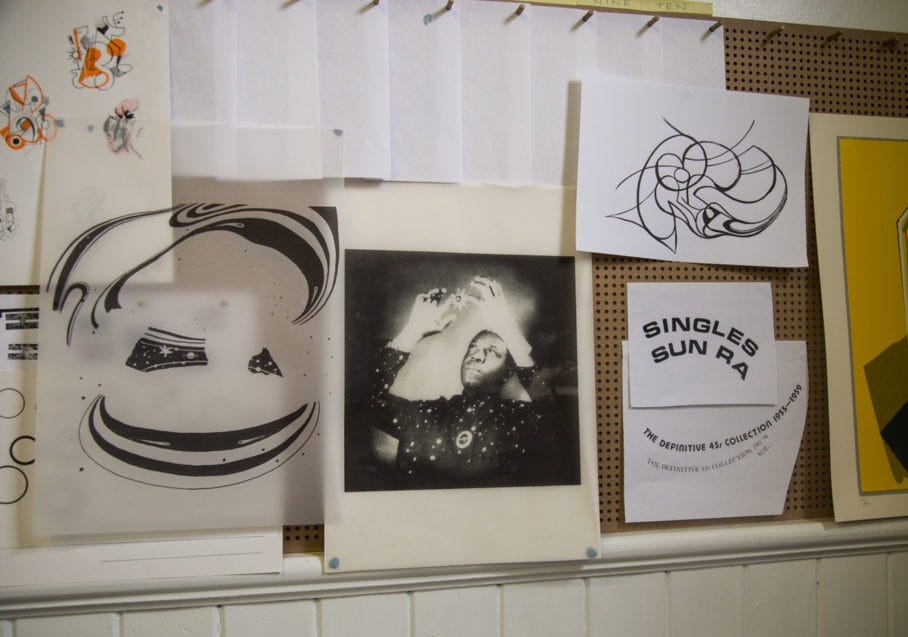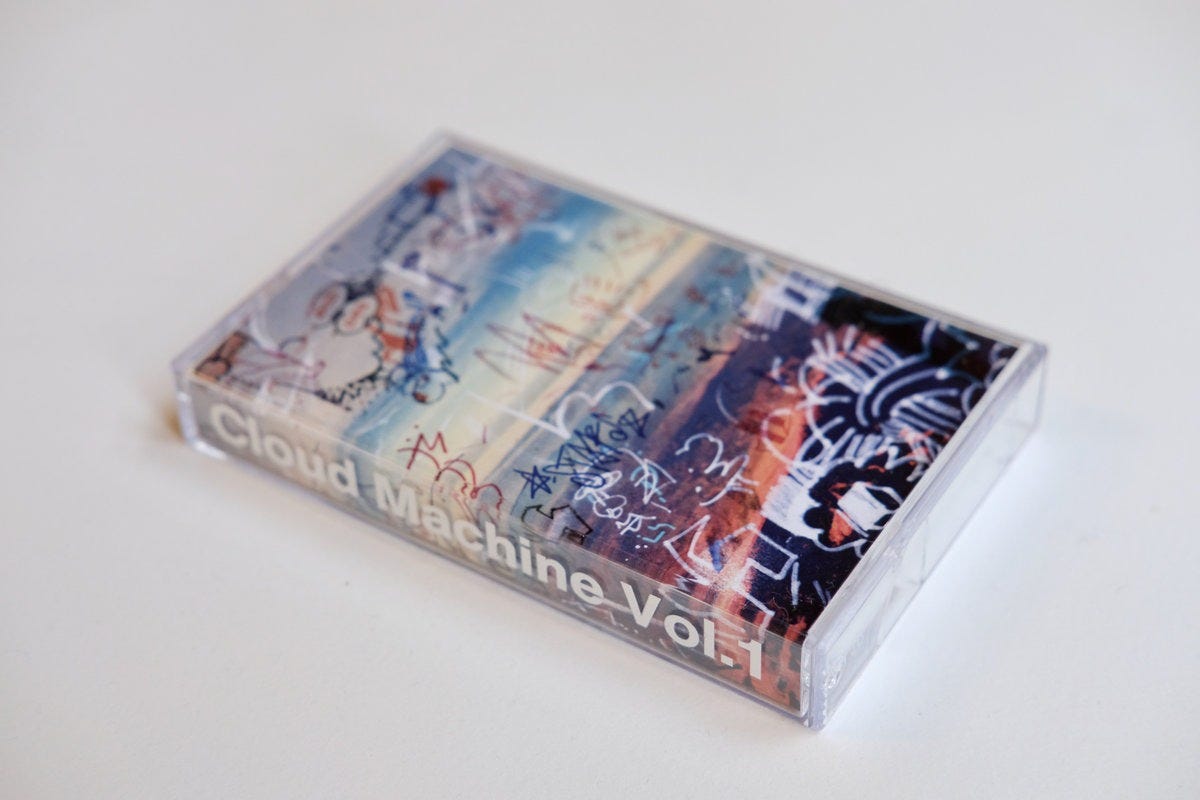Oscillating - pt.1
[waves/channels/cycles] - some notes to start 2025
NOTES FROM THE SILURIAN SEA BED
It’s early January, 2025 in the Gregorian calendar; Holocene 12025; Discordian 3191; Chinese 4516 among others, and (still, just) the year of the Wood Dragon. I’m standing in a small wooded area of Whitcliffe Common Nature Reserve, a piece of land that overlooks the serpentine River Teme - or Afon Tefeidiad in Welsh - which was some 415 Million years ago the deepest channel of a shallow tropical sea, as it passes by the base of Ludlow Castle. You can hear the bass thrum of the weir below if you tune into it, but the foreground sound is the melting of the snow from the pine canopy, down onto and through the semi-frozen duvet to the sodden leaves underneath. It feels like I’m a solo audience to an immersive, avant-garde percussion performance. Maybe it’s my ongoing obsession with the nature of rhythm, or more specifically, rhythm as the chromosomal structure of nature. Either way, it makes for a mouthwatering sound reminiscent of frying sausages.
A few metres’ walk up the path and there’s a branch holding enough melting snow to generate a metronomic sequence of drips, hitting the ground at a steady BPM around 141, fittingly the exact speed of Simon & Garfunkel’s ‘Hazy Shade of Winter’. I place the recorder on a fence to try to catch some of the rustling sound of the bushes, and it’s only later when reviewing the audio file that I realise the wires of the fence were also being plucked by falling snow, composing a soft, almost waltz-like bassline.1
NOTES FROM THE OSCILLATING DREAM SPACE
A wider definition of music as suggested by the likes of John Cage, Yoko Ono and Fluxus, Sun Ra, Brian Eno permeates everything when the world makes noises like this, and I am amongst it, and find myself thinking of Sun Ra speaking of being an instrument played by the cosmos. The drums of my ears and the fibres on my skin are being enlivened by these vibrations, and I’m happy I’m here for it.

One of my many favourite tracks by Sun Ra, Advice to Medics, also has one of my favourite stories attached to it, as told by his biographer John F. Szwed in Space is the Place. In 1956, he had been booked to perform solo to a group of patients at a psychiatric hospital, as part of a music therapy session. Sun Ra - for me the most important trickster of the past century - played with an apparent improvisational freedom, but one rooted in a legendarily strict formal discipline and a fundamental belief that what the dominant culture might deem a certain ‘wrongness’ was essential to music being a true force. As such it would have been a dereliction of duty to patronise this audience by making it somehow more ‘palatable’, as that would undermine its power. At one point as he was playing, a woman diagnosed with catatonia who hadn’t spoken or moved for years suddenly jumped out of her seat, ran up to the piano and screamed, “you CALL this MUSIC??“
To celebrate this success, he produced the album Cosmic Tones for Mental Therapy, which is not what you’d call easy listening. Sunny believed that (all) people needed to hear dissonance to shock them out of their condition, because only then could they escape the trap they were in. Camille Norment (whose essay gave this section its title2) put it that those ‘dissonant, piercing, wavering, and uncanny sound thoughts … these waveforms transmitted the past and future in a nonlinear structure'. Ironically, mainstream (white) culture of the time dismissed Sun Ra as either insane or a fraud: the former is, as Graham Lock says, part of a ‘long and alarming history of Western psychiatry diagnosing cultural difference as madness’3; the latter is a product of the imperial mentality’s refusal to permit contradictions, complexities, humour or intelligence in the dehumanised subject.
NOTES FROM THE FURROW
In late Summer last year, I completed the production of a short documentary commissioned by Animate Projects about a community garden in Derby: Hannah Fields, which was established by an ex-NHS Phychiatric Nurse to provide a space for recovery through connection to others and the land.
The required running time for the film was around 3 minutes, and with such a short space of time to work with, I wanted to find a symbol, motif or system that would help compress the subject somehow.

During the early discussions with the core members, a few themes began to come into focus: cyclical systems and the energies within them, emergent landforms through symbiotic farming systems, the harmonious use of the elements in Biodynamic agriculture, among many others. In researching further, I stumbled across a publication from 1965 by Theodor Schwenk called Sensitive Chaos, a beautifully-written rumination on shapes and patterns created by water, and how they form the foundation of all life. Vortices and the pulsing movement is seen in biodynamics as the ‘life-giving force’. Like a lot of biodynamic thinking, it has a poetic, spiritual and experimental dimension that leads those aligned with conventional scientific thought to term it pseudoscientific, but I recognise these elements as philosophical, and it’s a great example of what Henri Lefebvre termed Rhythmanalysis. (I also found the diagrams to be useful animation references, with one illustration of a stingray’s wave-like fin movements working as the frames of an animated loop.)

One of the distinguishing features of the Hannah Fields garden is a growing area delineated by a rare example of medieval Ridge & Furrow surviving within an urban development. The combination of this agricultural wave-form with the importance of the shape in biodynamics made it a clear choice for a symbolic heartbeat for the film. It also gave me a structure to describe the bringing-to-life of the land and the sick; from a stasis (a flat line) to a pulse.

FULL-CIRCLE
It’s mid-January. The year doesn’t really matter; the deep frost has melted away, and the snowdrops have appeared. Going back through my Sun Ra research library for this post, I fall across a quote in the Cheryl Lynn Bruce essay, Some Ra, which stops me dead in my tracks. The roots of the word delirium, she points out via Foucault, ‘is derived from [LAT] lira, ‘a furrow’; so that deliro … means to move out of the furrow, away from the proper path of reason.’4
All along, that symbol had signified something in our language that was hidden in plain sight: Hannah Fields, this place now dedicated to (mental) health recovery, has at its heart the very form that etymologically symbolised ‘sanity’. ‘I get a different way of living, here,’ said a participant during our last community group conversation in the garden, ‘and then when I go back [home], it’s all madness again’.
On Hannah Fields was completed in August and released online. You can watch it here:
It will have an in-person screening next alongside works by other artists including Karel Doing at The Metabolising Analogue at Vasulka Kitchen Brno, Czech Republic, on 16th Feb.
Thanks for reading/listening! It’s been a while. If the link between Sun Ra and a community garden in Derby seems random, welcome to my career… I see music and sound as the throughline, hence starting this dispatch with a recent study in rhythm.
I just have a couple of other bits to mention:
Quite a few of you have come to me recently via the incomparable Edge of Frame (big thanks to Edwin for the support). Those of you who don’t know, Edge of Frame is a blog and occasional screening event that champions experimental animation, and has been for over a decade an indispensable community-building resource. Edwin Rostron, who runs it, has revitalised it as a Substack as of this year - essential for anyone interested in the field. (Sign up for news of screening events in London very soon!)
My good friend and longtime collaborator DrumTalk has just released the beat tape Cloud Machine Vol. 1, which I was very happy to provide the artwork for. A producer’s tribute to the hiphop tradition of album interludes, it’s a very satisfying thing and the music is killer as always. You can buy it here; proceeds will go to Medical Aid for Palestinians.
It has the feeling of this piece by John Tilbury, from the album Seasides.
(“The titles of the improvised tracks are the names of former Palestinian villages that were depopulated or destroyed in 1948 at the time of the establishment of the state of Israel.”)
Camille Norment, ‘notes from the oscillating dream space’, in Corbett, Elms & Kapsalis, Pathways to Unknown Worlds: Sun Ra, El Saturn and Chicago’s Afro-Futurist Underground 1954-68, WhiteWalls (2006)
Graham Lock, ‘Right Place, Right Time, Wrong Planet (Chicago Talk Remix)’, in Corbett, Elm, Kapsalis, Travelling The Spaceways: Sun-Ra, The Astroblack and Other Solar Myths, WhiteWalls (2010)
Cheryl Lynn Bruce, ‘Some Ra’, in Corbett, Elm, Kapsalis (2010)





